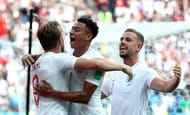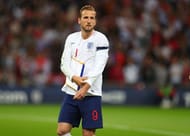
Win, lose or draw against Switzerland tonight, it’s pretty clear that England have some work to do if they want to progress from their semi-final finish at the 2018 World Cup.
Beaten by Spain in their first UEFA Nations League fixture on Saturday, Gareth Southgate’s side once again displayed a lot of heart and tenacity, scored a great goal and never looked truly out of the game – but they also showed the same problems and holes in their game that they displayed in their World Cup losses to Belgium and Croatia.
Southgate’s side clearly have a lot of potential, but here are three ways in which they could look to improve in order to become a truly elite international side.
#1 Consider changing formation

Ever since last November’s friendly games with Brazil and Germany, Southgate’s go-to formation for England has been a 3-5-2, with three central defenders, two wing-backs, a trio of midfielders – one holding, two attacking – and then two forwards. This tactic worked brilliantly in the World Cup – but only against weaker sides like Panama and Tunisia.
That’s not to say England only defeated weaker teams. Colombia and Sweden – solid opposition by anyone’s standards – were also put to the sword, but against Belgium and Croatia, and again when faced by Spain on Saturday, England faltered. The difference between Sweden and Spain is quite simple, too – the latter side have midfield players capable of superior ball retention to their English counterparts.
In essence then – only for sides capable of doing so of course – the blueprint to defeat Southgate’s 3-5-2 is written. Opponents push their own full-backs or wing-backs high up, forcing England’s pair backwards and essentially forcing the Three Lions into a 5-3-2 formation. From there they swarm the holding midfielder – most recently Jordan Henderson – and prevent him from linking with the attacking players, thus nullifying England’s threat substantially.
It’s becoming clear now that against sides capable of doing this then, the 3-5-2 comes up short. And yet Southgate seems determined to push forward with a three-man defence, and thus far it’s worked well. So when faced with teams like Spain or Croatia, why not go with a 3-4-3 formation instead?
This would mean the three-man defence and the two wing-backs remain, but one of the attacking midfielders – right now Dele Alli or Jesse Lingard – would be sacrificed for another central midfielder to provide support for Henderson and to prevent the forward line from needing to drop so deep, with the other moving into the forward line alongside most likely Harry Kane and Raheem Sterling.
The issue with this idea? Preferably, the second central midfielder would be a playmaker or a pass master in the mould of a Luka Modric or Sergio Busquets, but England’s World Cup squad did not possess such a player. That doesn’t mean they don’t exist, though – which leads on to the second point...
#2 Find a midfielder who can control the game

When England were defeated by Italy at Euro 2012 and again at the 2014 World Cup, the one area observers pointed to where the Three Lions were lacking was central midfield. Most notably, they pointed to the fact that Andrea Pirlo was able to control both games despite England having the likes of Steven Gerrard amongst their starting 11. It’s a problem that’s stuck with Gareth Southgate’s side despite all the progress they’ve made. For Pirlo in 2012, see Modric in 2018.
England’s World Cup squad simply didn’t include a true playmaker – the type of player able to create a chance seemingly from nothing by threading a pass through the eye of a needle – nor did it include a player capable of retaining the ball as well as a Pirlo or Modric. But thankfully, the missing piece of this puzzle might well be on the horizon.
Some of England’s younger players – players who might be able to break into the squad as early as the October internationals – could fill this role. James Maddison of Leicester, for instance, would fit the mould of the playmaker, and he’s also clearly capable of great ball retention. His stats back this up – in 2017/18 he created 8 goals and had a pass success rate of 86%, and he’s already created 1 goal in 4 Premier League appearances this season.
If England were to switch to a 3-4-3 formation – or even stick with the 3-5-2 and replace one of the ultra-attacking Lingard or Alli with a more subtle playmaker in Maddison – this would hopefully provide more protection for the holding player while also providing England’s forwards like Harry Kane with more chances.
There are others, too – Mason Mount is cut from a similar mould as Maddison but is perhaps less of the finished article, with Phil Foden in a similar boat. And Nathaniel Chalobah and Harry Winks likely wouldn’t create as many chances, but would certainly be able to retain possession in a stronger way than England currently do against sides like Spain. However, both men need more game time in order to regain their fitness after long-term injuries.
In essence, though, England do have some midfielders coming through capable of controlling a game. They just need to be given a chance – hopefully in the October international break.
#3 Find a strong backup option up front

Harry Kane was awarded the 2018 World Cup’s Golden Boot this weekend for his scoring exploits in Russia this summer – he scored 6 goals, the most of any player during the tournament – but it’s safe to say that right now, he isn’t firing on all cylinders. Kane has barely come under criticism for his performances as it’s quite clear that the effort is there, but it’s also clear that he looks tired right now.
It’s hardly a surprise. Since returning from an ankle injury in the spring, Kane has barely had time to draw a breath, as he’s hardly missed a game for Tottenham and England. Sure, he’s scored plenty of goals during that time – in the World Cup most notably – but he’s also appeared to be struggling for the Three Lions since his tremendous performance against Colombia in the round of 16 on the 3rd July.
The issue for England is that they hardly have a plethora of great strikers to call upon as a backup. Marcus Rashford has been deployed in the role but isn’t a pure striker like Kane – as his finishing proved against Spain – while Jamie Vardy has retired from international football. That means that finding a solid backup for Kane is a must before the next round of international fixtures.
Bournemouth’s Callum Wilson has been mentioned recently and surely deserves a shot – he’s suffered from bad injuries but when he’s been fit he has been a consistent goalscorer, and has already hit 2 goals this season. He also has past history with Southgate, having been capped by England U21 while Southgate managed them.
Other options could include Danny Ings – who is currently attempting to resurrect his stalled career at Southampton – and the already-capped duo of Tammy Abraham and Dominic Solanke. Issues surround all three, though – Abraham is now playing in the Championship with Aston Villa, Solanke is struggling for playing time at Liverpool, and Ings has barely played over the past few seasons.
A wildcard option could be Everton’s Dominic Calvert-Lewin – who scored the winner for England U20 in their 2017 World Cup triumph, and already has 3 goals this season – but again, playing time is the key.
Regardless, this is an area that Southgate needs to look at as soon as possible, otherwise, the risk of Kane suffering from serious burnout becomes ever more likely going forward.
